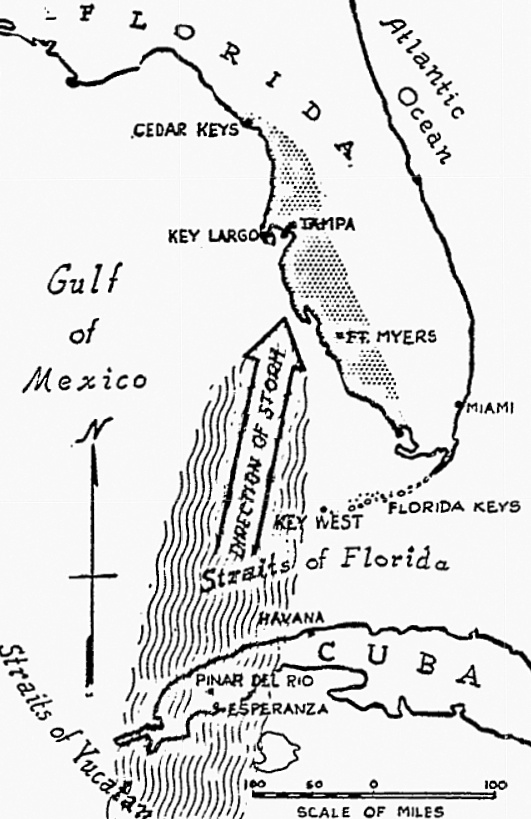The Pittsburgh Press (October 7, 1946)
Hurricane roars on Florida; beaches ordered evacuated
Storm due to sweep up Gulf Coast and may swing inland; winds 84 m.p.h. at center
Winds of destruction were sweeping on the west coast of Florida today as a tropical hurricane swept across Cuba and headed toward the United States. Shaded area in Florida shows the region alerted by the Weather Bureau.
MIAMI, Florida (UP) – Residents of low beaches on the Florida West Coast were warned to evacuate to high ground today, as a tropical hurricane roared up the Gulf of Mexico.
Winds of 84 miles per hour were reported from Dry Tortugas, westernmost of the string of keys below Florida, as the storm center passed to the westward. It is expected to sweep up the Gulf Coast of the state with full hurricane wings, of 75 m.p.h. and better.
Shelters were opened in all West Coast cities, boats sought haven in inland waters. Red Cross and military agencies prepared to aid thousands who might seek refuge. The storm had shifted from a northerly to a north-northeastward direction, increasing chances that it would strike inland tonight.
The Miami Weather Bureau warned that beaches should be evacuated.
With winds of 100 m.p.h. shrieking around the placid center of the storm, gales blanketed the lower part of Florida. At noon today the center was placed 130 miles west of Key West.
Storm crosses Cuba
“The hurricane will continue on its present (north or north-northeastward) course and cause hurricane winds along the West Florida coast with strong winds to gales prevailing over the remainder of the Florida Peninsula during the next 24 to 36 hours,” the Weather Bureau said.
The storm had cut across Cuba during the night, causing damage not yet fully reported, and moved across the Straits of Florida and past the end of the keys.
There was a strong possibility that it would cut inland at some time during the night, most likely near Tampa, and in that case would endanger the heavy fruit crop.
Miami to be spared
There was virtually no chance that the full force would strike Miami. But the resort city expects 50-mile winds late today. The wind was recorded at 40 miles as hour during the morning. Few citizens boarded their windows.
The Red Cross in Miami announced that it would not open its shelters tonight unless there is a sudden change in course. Shelters were opened at dawn in Key West, and were prepared in Tampa, St. Petersburg, Sarasota, Fort Myers and other West Coast cities.
No residents of the keys went to the mainland during the night and morning, the Red Cross said. But some were believed to have gone into Key West. Preparations for the most part were confined to the lower Gulf Coast.
115-mile winds reported
Hurricane warnings, the black and red signals, stood stiff in the air from Key Largo to Cedar Keys, on the gulf across the state from Daytona Beach. Storm signals were hoisted over all the remainder of the peninsula.
The hurricane was believed to have hit the Cuban coast in the vicinity of Corrientes Bay on the southwestern tip of the island. Its northeasterly course took it along the Sierra de Los Organos Mountains. It cut a 100-mile-long swath of destruction to emerge in the vicinity of Esperanza, about 100 miles southwest of Havana, where it cut across the Florida Strait toward the Florida coast.
La Fe, a former U.S. Navy searchlight and radar station, was reported hit. San Julian, in the same area, reported gusts of winds up to 115 miles an hour when it struck there.
Torrential rains accompanied the storm across Cuba. Havana was buffeted by strong winds.
There was no immediate report of damage in Cuba. But torrential rains which accompanied the winds caused a cave-in of the aqueduct section of the Rancho Boyeros Highway west of Havana. Communications with Pinar Del Rio, a rich tobacco growing province of Western Cuba, had been severed by the storm.
Hits populated area
The path of the storm was through a fairly heavily populated area of Cuba where about 20 years ago 600 persons were killed in a hurricane.
The Army, Navy and Coast Guard took all possible precautions to minimize the loss of life and property damage in Florida. Leaves of all personnel were canceled and planes were flown out of the danger area.
All commercial flights in the storm area were canceled. Observers kept track of the storm by weather planes which flew around it and charted its course.
Second of season
The storm developed in Yucatan Strait southwest of Cuba and whipped into a fury so rapidly that winds of 50 miles an hour were reported at its center by the time the weather bureau could get out its first warning bulletin at 8 a.m. yesterday.
The storm was the second of the tropical hurricane season. The first storm blew up out of the Caribbean about three weeks ago. But it skirted the mainland and dissipated itself at sea. The heavy winds caused a Norwegian freighter to founder off Cape Hatteras with a heavy loss of life.
